Kinh nghiệm giải quyết việc làm đối với đồng bào dân tộc thiểu số tái định cư do xây dựng thủy điện ở một số quốc gia khu vực Đông Nam Á
Việc xây dựng, phát triển thủy điện luôn có tầm quan trọng và ý nghĩa
đặc biệt về kinh tế - xã hội, quốc phòng, an ninh của mỗi quốc gia. Từ
khi bắt đầu triển khai lập kế hoạch tới khi nhà máy được đưa vào vận
hành, vấn đề tái định cư cho người dân bị ảnh hưởng do xây dựng thủy
điện còn nhiều bất cập. Một trong những thiếu sót dẫn tới bất cập đó là
chính sách giải quyết việc làm đối với đồng bào dân tộc thiểu số trong
bối cảnh tái định cư do xây dựng thủy điện chưa được nghiên cứu sâu cả
trong nước cũng như nước ngoài. Hầu hết các khu vực xây dựng thủy
điện trọng điểm là nơi cư trú chủ yếu của đồng bào dân tộc thiểu số, đó
là nhóm người dễ bị tổn thương nhất nhưng lại là những người chịu ảnh
hưởng trực tiếp của quá trình tái định cư. Giải quyết việc làm chính là
bình ổn cuộc sống của đồng bào dân tộc thiểu số sau tái định cư nhằm
bình thường và phát triển cuộc sống cũng như an ninh, xã hội, kinh tế
vùng đồng bào cư trú. Bằng phương pháp nghiên cứu thực tiễn, phân tích
tổng kết kinh nghiệm của Lào, Myanmar, Thái Lan và Campuchia, các
quốc gia thuộc nhóm Đông Nam Á lục địa có cùng tiềm năng phát triển
thủy điện giống Việt Nam, nghiên cứu đưa ra bài học để xây dựng, hoàn
chỉnh chính sách giải quyết việc làm đối với đồng bào dân tộc thiểu số
tái định cư do xây dựng thủy điện ở Việt Nam.
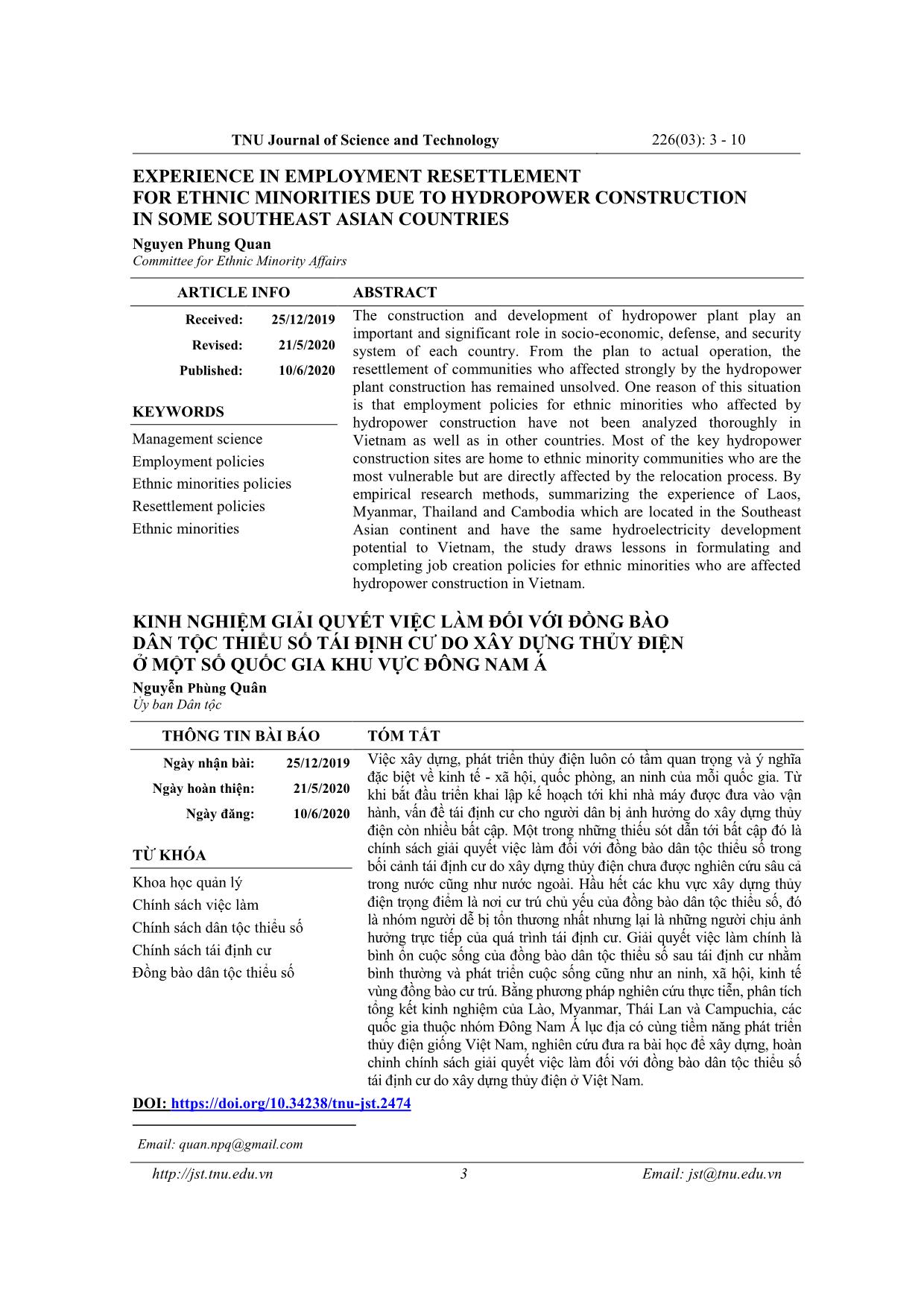
Trang 1
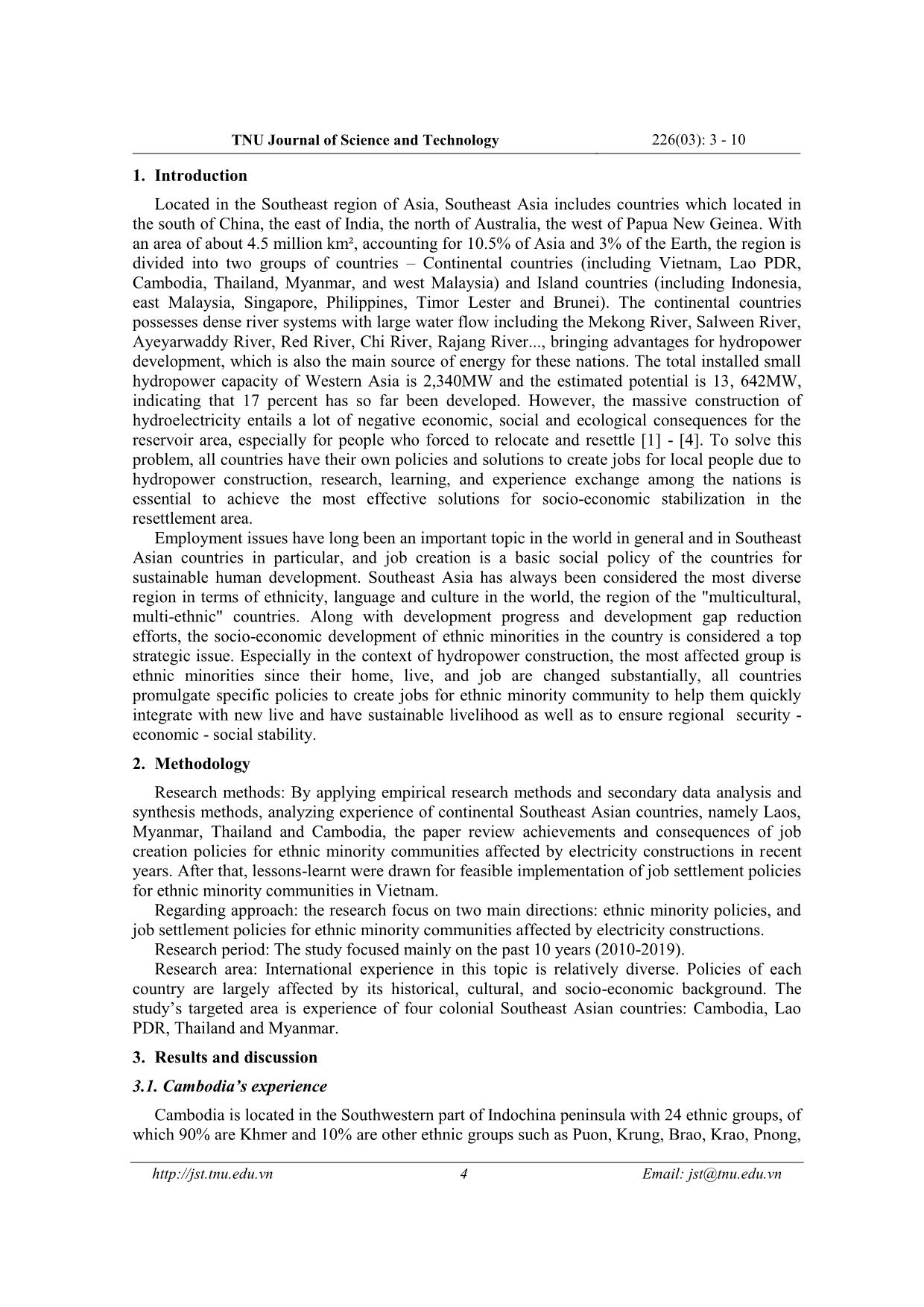
Trang 2
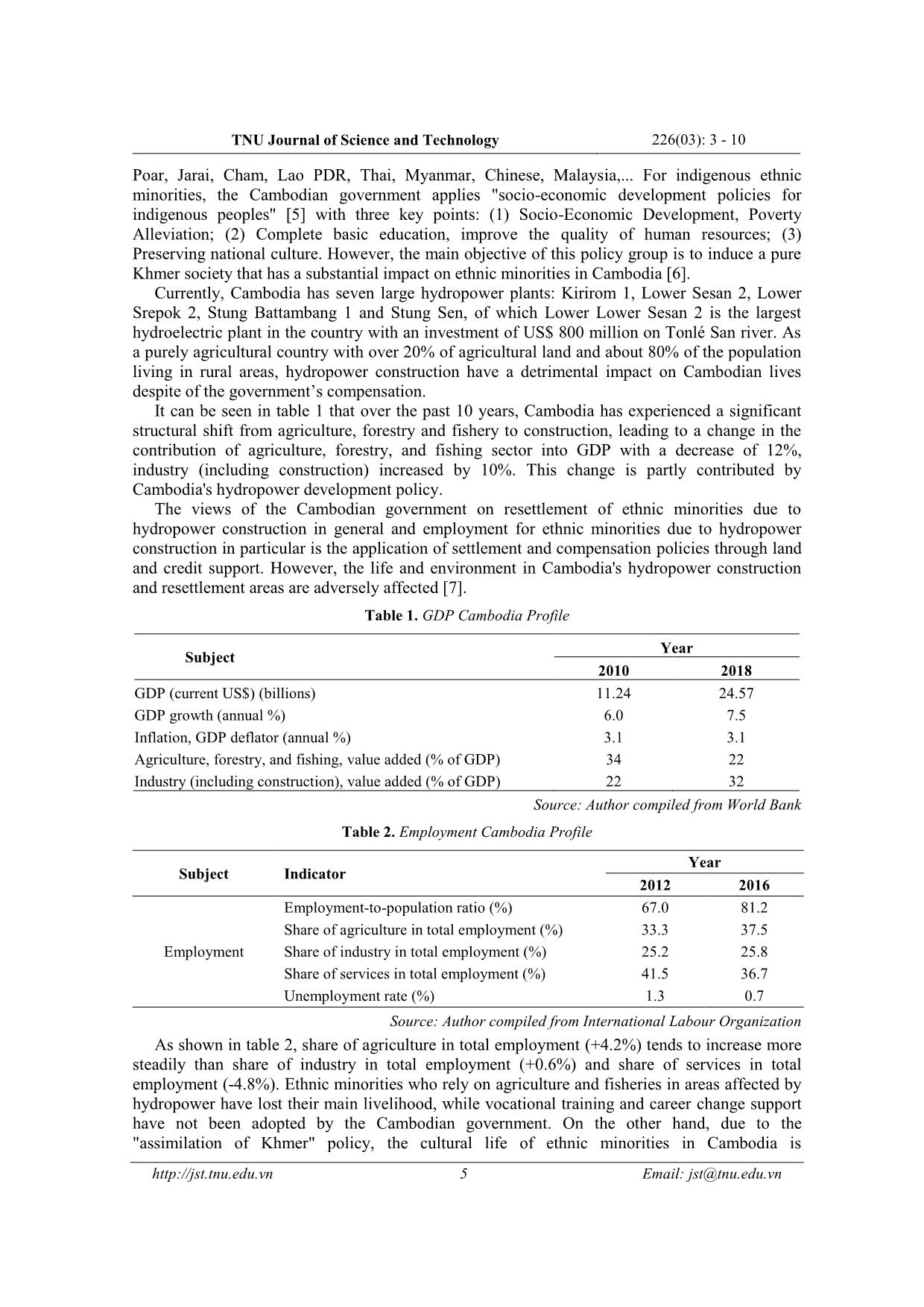
Trang 3
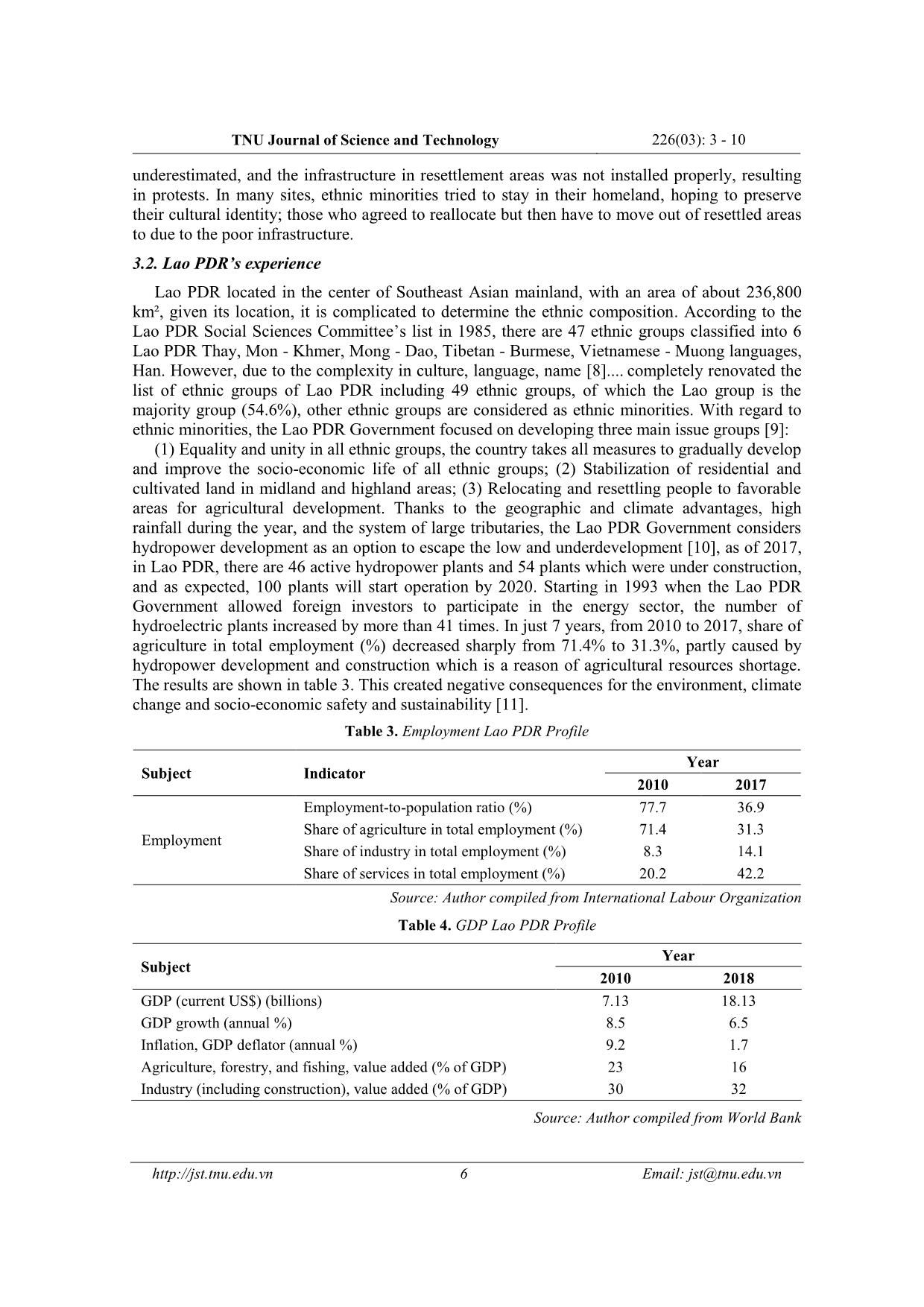
Trang 4
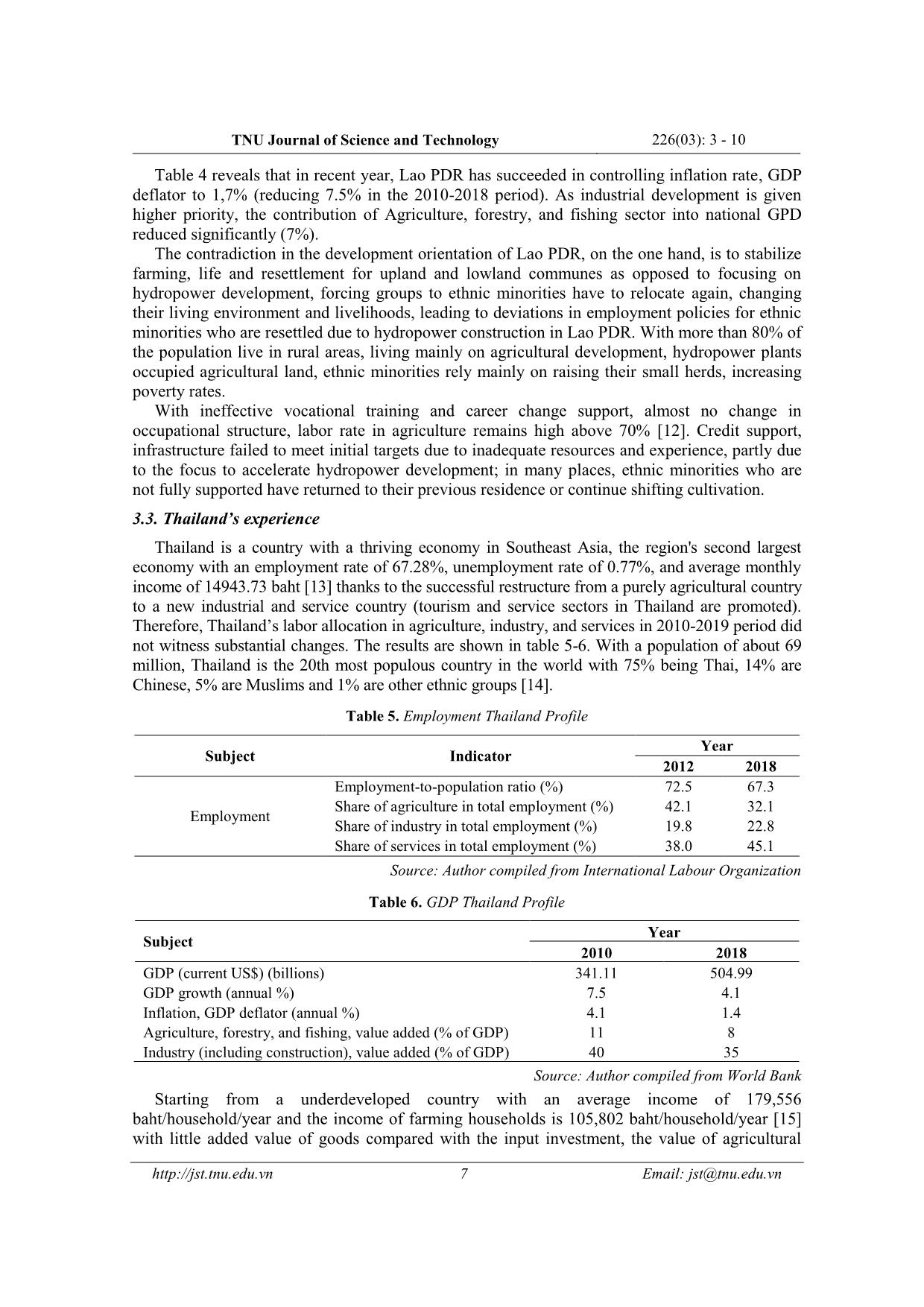
Trang 5
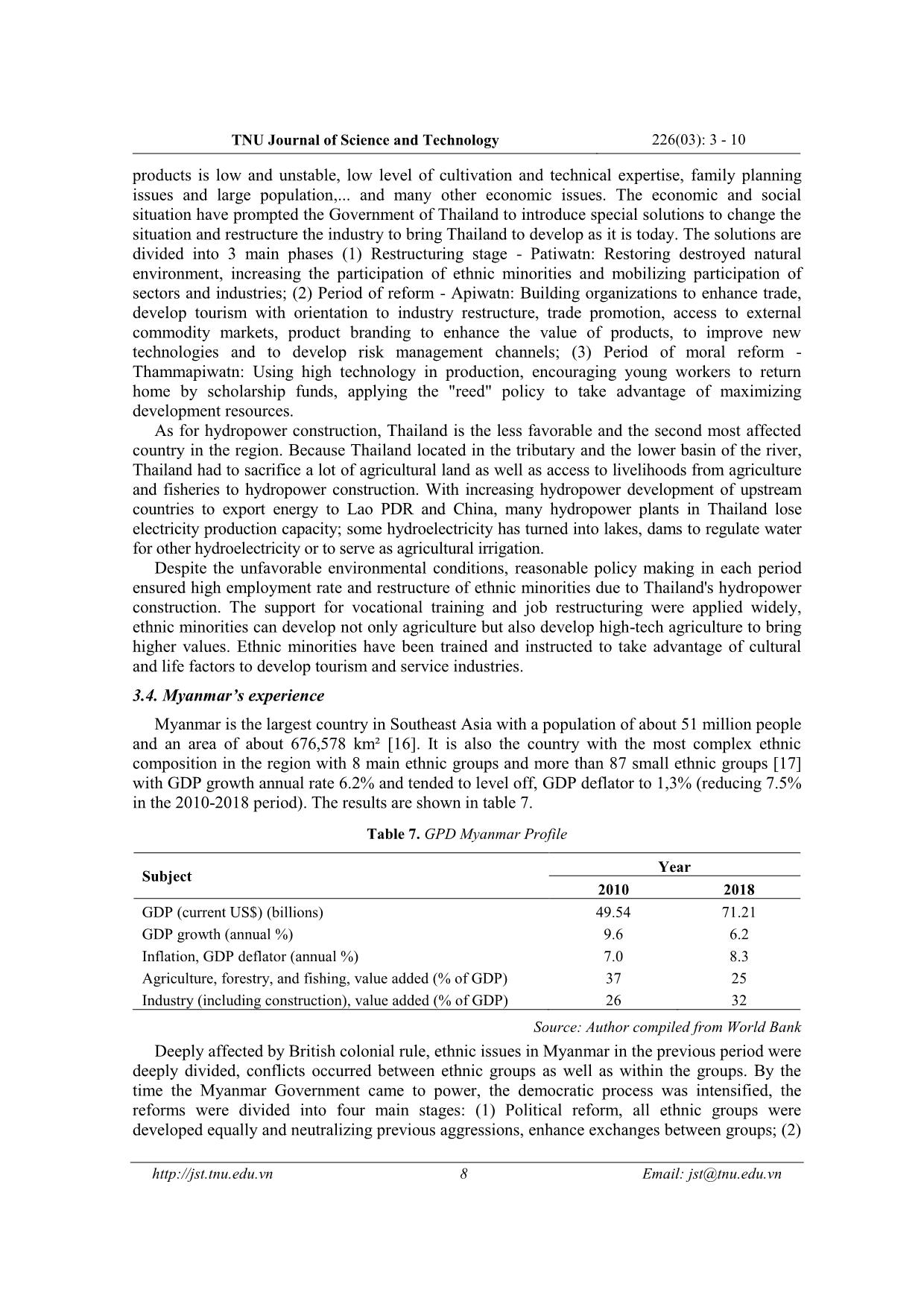
Trang 6
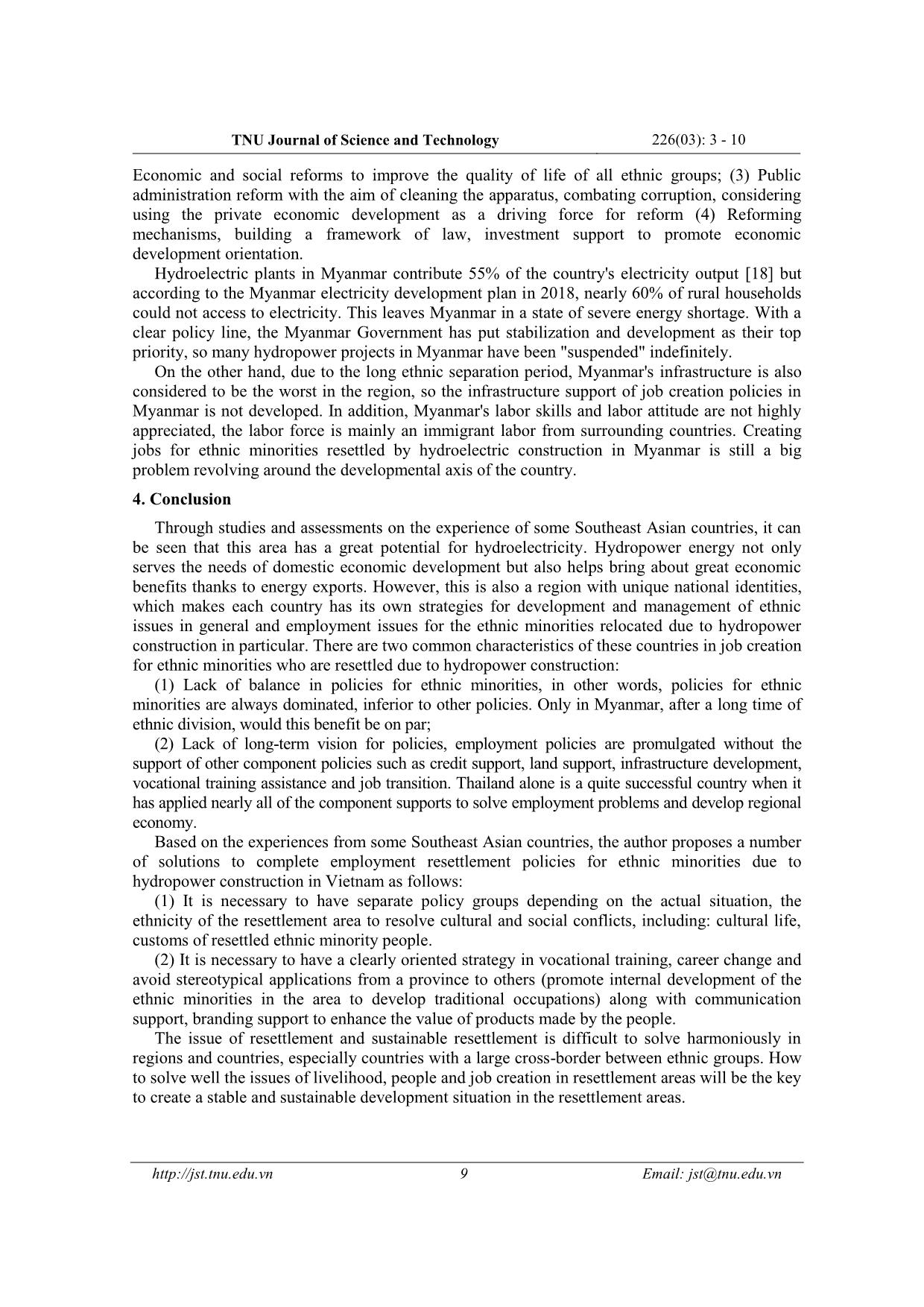
Trang 7
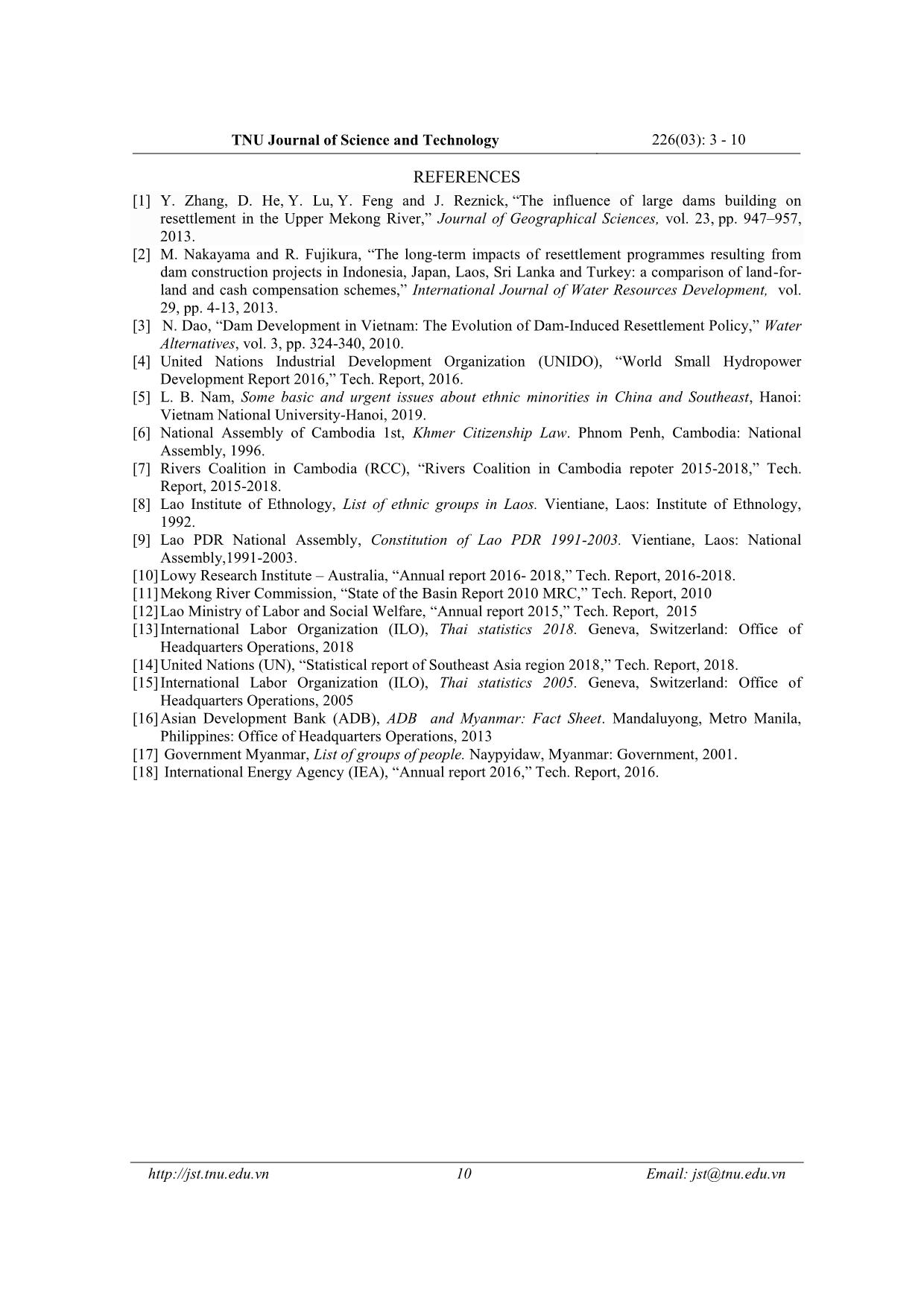
Trang 8
Tóm tắt nội dung tài liệu: Kinh nghiệm giải quyết việc làm đối với đồng bào dân tộc thiểu số tái định cư do xây dựng thủy điện ở một số quốc gia khu vực Đông Nam Á
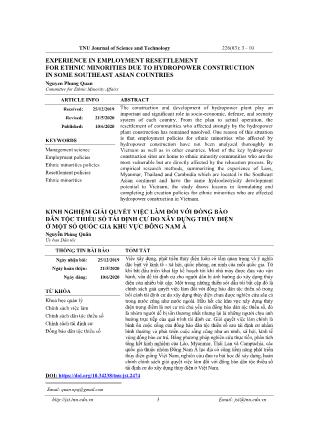
Starting in 1993 when the Lao PDR Government allowed foreign investors to participate in the energy sector, the number of hydroelectric plants increased by more than 41 times. In just 7 years, from 2010 to 2017, share of agriculture in total employment (%) decreased sharply from 71.4% to 31.3%, partly caused by hydropower development and construction which is a reason of agricultural resources shortage. The results are shown in table 3. This created negative consequences for the environment, climate change and socio-economic safety and sustainability [11]. Table 3. Employment Lao PDR Profile Subject Indicator Year 2010 2017 Employment Employment-to-population ratio (%) 77.7 36.9 Share of agriculture in total employment (%) 71.4 31.3 Share of industry in total employment (%) 8.3 14.1 Share of services in total employment (%) 20.2 42.2 Source: Author compiled from International Labour Organization Table 4. GDP Lao PDR Profile Subject Year 2010 2018 GDP (current US$) (billions) 7.13 18.13 GDP growth (annual %) 8.5 6.5 Inflation, GDP deflator (annual %) 9.2 1.7 Agriculture, forestry, and fishing, value added (% of GDP) 23 16 Industry (including construction), value added (% of GDP) 30 32 Source: Author compiled from World Bank TNU Journal of Science and Technology 226(03): 3 - 10 7 Email: jst@tnu.edu.vn Table 4 reveals that in recent year, Lao PDR has succeeded in controlling inflation rate, GDP deflator to 1,7% (reducing 7.5% in the 2010-2018 period). As industrial development is given higher priority, the contribution of Agriculture, forestry, and fishing sector into national GPD reduced significantly (7%). The contradiction in the development orientation of Lao PDR, on the one hand, is to stabilize farming, life and resettlement for upland and lowland communes as opposed to focusing on hydropower development, forcing groups to ethnic minorities have to relocate again, changing their living environment and livelihoods, leading to deviations in employment policies for ethnic minorities who are resettled due to hydropower construction in Lao PDR. With more than 80% of the population live in rural areas, living mainly on agricultural development, hydropower plants occupied agricultural land, ethnic minorities rely mainly on raising their small herds, increasing poverty rates. With ineffective vocational training and career change support, almost no change in occupational structure, labor rate in agriculture remains high above 70% [12]. Credit support, infrastructure failed to meet initial targets due to inadequate resources and experience, partly due to the focus to accelerate hydropower development; in many places, ethnic minorities who are not fully supported have returned to their previous residence or continue shifting cultivation. 3.3. Thailand’s experience Thailand is a country with a thriving economy in Southeast Asia, the region's second largest economy with an employment rate of 67.28%, unemployment rate of 0.77%, and average monthly income of 14943.73 baht [13] thanks to the successful restructure from a purely agricultural country to a new industrial and service country (tourism and service sectors in Thailand are promoted). Therefore, Thailand’s labor allocation in agriculture, industry, and services in 2010-2019 period did not witness substantial changes. The results are shown in table 5-6. With a population of about 69 million, Thailand is the 20th most populous country in the world with 75% being Thai, 14% are Chinese, 5% are Muslims and 1% are other ethnic groups [14]. Table 5. Employment Thailand Profile Subject Indicator Year 2012 2018 Employment Employment-to-population ratio (%) 72.5 67.3 Share of agriculture in total employment (%) 42.1 32.1 Share of industry in total employment (%) 19.8 22.8 Share of services in total employment (%) 38.0 45.1 Source: Author compiled from International Labour Organization Table 6. GDP Thailand Profile Subject Year 2010 2018 GDP (current US$) (billions) 341.11 504.99 GDP growth (annual %) 7.5 4.1 Inflation, GDP deflator (annual %) 4.1 1.4 Agriculture, forestry, and fishing, value added (% of GDP) 11 8 Industry (including construction), value added (% of GDP) 40 35 Source: Author compiled from World Bank Starting from a underdeveloped country with an average income of 179,556 baht/household/year and the income of farming households is 105,802 baht/household/year [15] with little added value of goods compared with the input investment, the value of agricultural TNU Journal of Science and Technology 226(03): 3 - 10 8 Email: jst@tnu.edu.vn products is low and unstable, low level of cultivation and technical expertise, family planning issues and large population,... and many other economic issues. The economic and social situation have prompted the Government of Thailand to introduce special solutions to change the situation and restructure the industry to bring Thailand to develop as it is today. The solutions are divided into 3 main phases (1) Restructuring stage - Patiwatn: Restoring destroyed natural environment, increasing the participation of ethnic minorities and mobilizing participation of sectors and industries; (2) Period of reform - Apiwatn: Building organizations to enhance trade, develop tourism with orientation to industry restructure, trade promotion, access to external commodity markets, product branding to enhance the value of products, to improve new technologies and to develop risk management channels; (3) Period of moral reform - Thammapiwatn: Using high technology in production, encouraging young workers to return home by scholarship funds, applying the "reed" policy to take advantage of maximizing development resources. As for hydropower construction, Thailand is the less favorable and the second most affected country in the region. Because Thailand located in the tributary and the lower basin of the river, Thailand had to sacrifice a lot of agricultural land as well as access to livelihoods from agriculture and fisheries to hydropower construction. With increasing hydropower development of upstream countries to export energy to Lao PDR and China, many hydropower plants in Thailand lose electricity production capacity; some hydroelectricity has turned into lakes, dams to regulate water for other hydroelectricity or to serve as agricultural irrigation. Despite the unfavorable environmental conditions, reasonable policy making in each period ensured high employment rate and restructure of ethnic minorities due to Thailand's hydropower construction. The support for vocational training and job restructuring were applied widely, ethnic minorities can develop not only agriculture but also develop high-tech agriculture to bring higher values. Ethnic minorities have been trained and instructed to take advantage of cultural and life factors to develop tourism and service industries. 3.4. Myanmar’s experience Myanmar is the largest country in Southeast Asia with a population of about 51 million people and an area of about 676,578 km² [16]. It is also the country with the most complex ethnic composition in the region with 8 main ethnic groups and more than 87 small ethnic groups [17] with GDP growth annual rate 6.2% and tended to level off, GDP deflator to 1,3% (reducing 7.5% in the 2010-2018 period). The results are shown in table 7. Table 7. GPD Myanmar Profile Subject Year 2010 2018 GDP (current US$) (billions) 49.54 71.21 GDP growth (annual %) 9.6 6.2 Inflation, GDP deflator (annual %) 7.0 8.3 Agriculture, forestry, and fishing, value added (% of GDP) 37 25 Industry (including construction), value added (% of GDP) 26 32 Source: Author compiled from World Bank Deeply affected by British colonial rule, ethnic issues in Myanmar in the previous period were deeply divided, conflicts occurred between ethnic groups as well as within the groups. By the time the Myanmar Government came to power, the democratic process was intensified, the reforms were divided into four main stages: (1) Political reform, all ethnic groups were developed equally and neutralizing previous aggressions, enhance exchanges between groups; (2) TNU Journal of Science and Technology 226(03): 3 - 10 9 Email: jst@tnu.edu.vn Economic and social reforms to improve the quality of life of all ethnic groups; (3) Public administration reform with the aim of cleaning the apparatus, combating corruption, considering using the private economic development as a driving force for reform (4) Reforming mechanisms, building a framework of law, investment support to promote economic development orientation. Hydroelectric plants in Myanmar contribute 55% of the country's electricity output [18] but according to the Myanmar electricity development plan in 2018, nearly 60% of rural households could not access to electricity. This leaves Myanmar in a state of severe energy shortage. With a clear policy line, the Myanmar Government has put stabilization and development as their top priority, so many hydropower projects in Myanmar have been "suspended" indefinitely. On the other hand, due to the long ethnic separation period, Myanmar's infrastructure is also considered to be the worst in the region, so the infrastructure support of job creation policies in Myanmar is not developed. In addition, Myanmar's labor skills and labor attitude are not highly appreciated, the labor force is mainly an immigrant labor from surrounding countries. Creating jobs for ethnic minorities resettled by hydroelectric construction in Myanmar is still a big problem revolving around the developmental axis of the country. 4. Conclusion Through studies and assessments on the experience of some Southeast Asian countries, it can be seen that this area has a great potential for hydroelectricity. Hydropower energy not only serves the needs of domestic economic development but also helps bring about great economic benefits thanks to energy exports. However, this is also a region with unique national identities, which makes each country has its own strategies for development and management of ethnic issues in general and employment issues for the ethnic minorities relocated due to hydropower construction in particular. There are two common characteristics of these countries in job creation for ethnic minorities who are resettled due to hydropower construction: (1) Lack of balance in policies for ethnic minorities, in other words, policies for ethnic minorities are always dominated, inferior to other policies. Only in Myanmar, after a long time of ethnic division, would this benefit be on par; (2) Lack of long-term vision for policies, employment policies are promulgated without the support of other component policies such as credit support, land support, infrastructure development, vocational training assistance and job transition. Thailand alone is a quite successful country when it has applied nearly all of the component supports to solve employment problems and develop regional economy. Based on the experiences from some Southeast Asian countries, the author proposes a number of solutions to complete employment resettlement policies for ethnic minorities due to hydropower construction in Vietnam as follows: (1) It is necessary to have separate policy groups depending on the actual situation, the ethnicity of the resettlement area to resolve cultural and social conflicts, including: cultural life, customs of resettled ethnic minority people. (2) It is necessary to have a clearly oriented strategy in vocational training, career change and avoid stereotypical applications from a province to others (promote internal development of the ethnic minorities in the area to develop traditional occupations) along with communication support, branding support to enhance the value of products made by the people. The issue of resettlement and sustainable resettlement is difficult to solve harmoniously in regions and countries, especially countries with a large cross-border between ethnic groups. How to solve well the issues of livelihood, people and job creation in resettlement areas will be the key to create a stable and sustainable development situation in the resettlement areas. TNU Journal of Science and Technology 226(03): 3 - 10 10 Email: jst@tnu.edu.vn REFERENCES [1] Y. Zhang, D. He, Y. Lu, Y. Feng and J. Reznick, “The influence of large dams building on resettlement in the Upper Mekong River,” Journal of Geographical Sciences, vol. 23, pp. 947–957, 2013. [2] M. Nakayama and R. Fujikura, “The long-term impacts of resettlement programmes resulting from dam construction projects in Indonesia, Japan, Laos, Sri Lanka and Turkey: a comparison of land-for- land and cash compensation schemes,” International Journal of Water Resources Development, vol. 29, pp. 4-13, 2013. [3] N. Dao, “Dam Development in Vietnam: The Evolution of Dam-Induced Resettlement Policy,” Water Alternatives, vol. 3, pp. 324-340, 2010. [4] United Nations Industrial Development Organization (UNIDO), “World Small Hydropower Development Report 2016,” Tech. Report, 2016. [5] L. B. Nam, Some basic and urgent issues about ethnic minorities in China and Southeast, Hanoi: Vietnam National University-Hanoi, 2019. [6] National Assembly of Cambodia 1st, Khmer Citizenship Law. Phnom Penh, Cambodia: National Assembly, 1996. [7] Rivers Coalition in Cambodia (RCC), “Rivers Coalition in Cambodia repoter 2015-2018,” Tech. Report, 2015-2018. [8] Lao Institute of Ethnology, List of ethnic groups in Laos. Vientiane, Laos: Institute of Ethnology, 1992. [9] Lao PDR National Assembly, Constitution of Lao PDR 1991-2003. Vientiane, Laos: National Assembly,1991-2003. [10] Lowy Research Institute – Australia, “Annual report 2016- 2018,” Tech. Report, 2016-2018. [11] Mekong River Commission, “State of the Basin Report 2010 MRC,” Tech. Report, 2010 [12] Lao Ministry of Labor and Social Welfare, “Annual report 2015,” Tech. Report, 2015 [13] International Labor Organization (ILO), Thai statistics 2018. Geneva, Switzerland: Office of Headquarters Operations, 2018 [14] United Nations (UN), “Statistical report of Southeast Asia region 2018,” Tech. Report, 2018. [15] International Labor Organization (ILO), Thai statistics 2005. Geneva, Switzerland: Office of Headquarters Operations, 2005 [16] Asian Development Bank (ADB), ADB and Myanmar: Fact Sheet. Mandaluyong, Metro Manila, Philippines: Office of Headquarters Operations, 2013 [17] Government Myanmar, List of groups of people. Naypyidaw, Myanmar: Government, 2001. [18] International Energy Agency (IEA), “Annual report 2016,” Tech. Report, 2016.
File đính kèm:
 kinh_nghiem_giai_quyet_viec_lam_doi_voi_dong_bao_dan_toc_thi.pdf
kinh_nghiem_giai_quyet_viec_lam_doi_voi_dong_bao_dan_toc_thi.pdf

